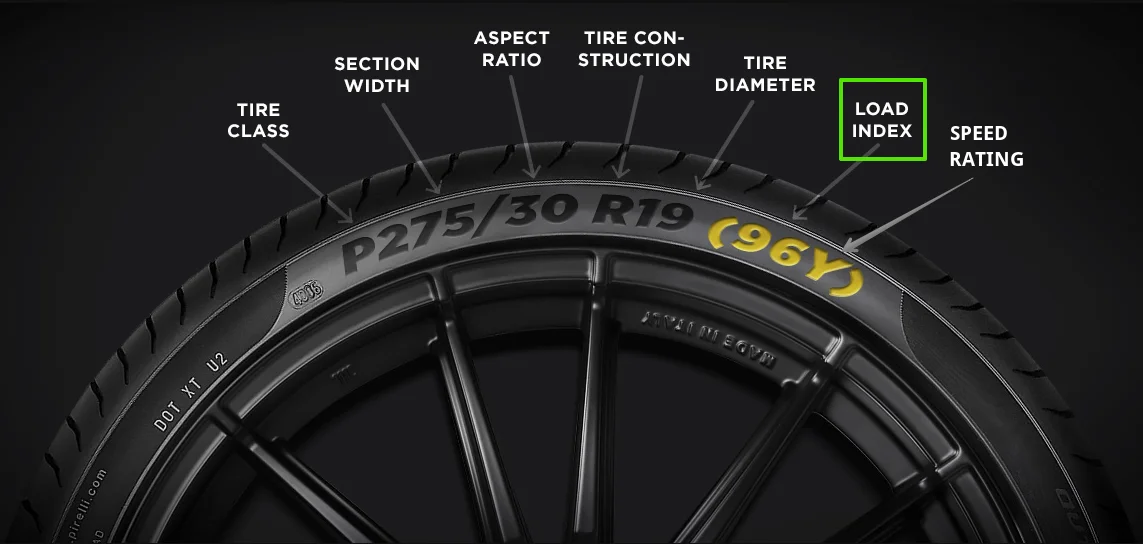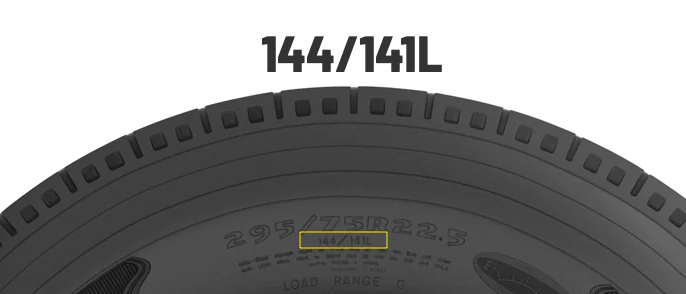Tire Load Index Chart

On any vehicle, the tires are the only contact that the vehicle gets with the surface. As they are primarily responsible for keeping you safe on the road, keeping them in good shape is essential. One thing that many people tend to overlook when it comes to tire usage is the tire load index.
What Exactly is the Tire Load Index?
A tire load index is the maximum amount of weight that you can put on a tire and drive it safely. The tire load index chart represents a combination of the tire’s ability to carry weight at a certain maximum speed as long as the pressure is in the optimal range. All of these parameters are set by the manufacturer.
Why is the Tire Load Index Important?
As each tire is rated at a certain maximum weight, the tire load index is one of the essential aspects you should consider. During the manufacturing process, the tires are tested, and the manufacturer determines the maximum weight they can carry before becoming unsafe to drive. The dangers of putting too much weight on the tires can range from premature wear to puncture or a blowout.
Using the Tire Load Index Chart
As your car has a maximum amount of weight it can carry, so do the tires, and they are often intertwined. On the tire side of things, a tire load index is a number associated with the maximum weight the tire can handle. In most passenger cars, the load rating ranges from 70 to 150, but it can go more on tires designed for bigger vehicles that carry bigger loads.
Each tire load index is associated with the amount of weight presented in pounds. For example, if your tire load index is 100, it means that one tire can hold a maximum of 1764 pounds. One thing to note is that even though the tire can carry more, it is not recommended to do so, as you increase the chances of damage to it. As the tire load index is for just one tire, to calculate the maximum of all 4 corners, you’ll need to multiply it by 4. For the example above, if each tire has an index of 100 capable of carrying 1764 pounds, the maximum amount of weight you can put on the vehicle is 7056 pounds. One thing to note is that this is the total, including the car’s weight. To determine the actual load you can put on the car, you’ll need to deduct the weight of the car from the maximum weight the tires can handle.
| Load Index | Load (lbs) |
|---|---|
| 0 | 99 |
| 1 | 102 |
| 2 | 105 |
| 3 | 107 |
| 4 | 110 |
| 5 | 114 |
| 6 | 117 |
| 7 | 120 |
| 8 | 123 |
| 9 | 128 |
| 10 | 132 |
| 11 | 136 |
| 12 | 139 |
| 13 | 143 |
| 14 | 148 |
| 15 | 152 |
| 16 | 157 |
| 17 | 161 |
| 18 | 165 |
| 19 | 171 |
| 20 | 176 |
| 21 | 182 |
| 22 | 187 |
| 23 | 193 |
| 24 | 198 |
| 25 | 204 |
| 26 | 209 |
| 27 | 215 |
| 28 | 220 |
| 29 | 227 |
| 30 | 234 |
| 31 | 240 |
| 32 | 247 |
| 33 | 254 |
| 34 | 260 |
| 35 | 267 |
| 36 | 276 |
| 37 | 282 |
| 38 | 291 |
| 39 | 300 |
| 40 | 309 |
| 41 | 320 |
| 42 | 331 |
| 43 | 342 |
| 44 | 353 |
| 45 | 364 |
| 46 | 375 |
| 47 | 386 |
| 48 | 397 |
| 49 | 408 |
| Load Index | Load (lbs) |
|---|---|
| 50 | 419 |
| 51 | 430 |
| 52 | 441 |
| 53 | 454 |
| 54 | 467 |
| 55 | 481 |
| 56 | 494 |
| 57 | 507 |
| 58 | 520 |
| 59 | 536 |
| 60 | 551 |
| 61 | 567 |
| 62 | 584 |
| 63 | 600 |
| 64 | 617 |
| 65 | 639 |
| 66 | 639 |
| 67 | 677 |
| 68 | 694 |
| 69 | 716 |
| 70 | 739 |
| 71 | 761 |
| 72 | 783 |
| 73 | 805 |
| 74 | 827 |
| 75 | 852 |
| 76 | 882 |
| 77 | 908 |
| 78 | 937 |
| 79 | 963 |
| 80 | 992 |
| 81 | 1019 |
| 82 | 1047 |
| 83 | 1074 |
| 84 | 1102 |
| 85 | 1135 |
| 86 | 1168 |
| 87 | 1201 |
| 88 | 1235 |
| 89 | 1279 |
| 90 | 1323 |
| 91 | 1356 |
| 92 | 1389 |
| 93 | 1433 |
| 94 | 1477 |
| 95 | 1521 |
| 96 | 1565 |
| 97 | 1609 |
| 98 | 1653 |
| 99 | 1709 |
| Load Index | Load (lbs) |
|---|---|
| 100 | 1764 |
| 101 | 1819 |
| 102 | 1874 |
| 103 | 1929 |
| 104 | 1984 |
| 105 | 2039 |
| 106 | 2094 |
| 107 | 2149 |
| 108 | 2205 |
| 109 | 2271 |
| 110 | 2337 |
| 111 | 2403 |
| 112 | 2469 |
| 113 | 2535 |
| 114 | 2601 |
| 115 | 2679 |
| 116 | 2756 |
| 117 | 2833 |
| 118 | 2910 |
| 119 | 2998 |
| 120 | 3086 |
| 121 | 3197 |
| 122 | 3307 |
| 123 | 3417 |
| 124 | 3527 |
| 125 | 3638 |
| 126 | 3748 |
| 127 | 3858 |
| 128 | 3968 |
| 129 | 4079 |
| 130 | 4189 |
| 131 | 4289 |
| 132 | 4409 |
| 133 | 4541 |
| 134 | 4674 |
| 135 | 4806 |
| 136 | 4938 |
| 137 | 5071 |
| 138 | 5203 |
| 139 | 5357 |
| 140 | 5512 |
| 141 | 5677 |
| 142 | 5842 |
| 143 | 6008 |
| 144 | 6173 |
| 145 | 6393 |
| 146 | 6614 |
| 147 | 6779 |
| 148 | 6844 |
| 149 | 7165 |
| 150 | 7385 |
Light Truck Tire Load Index
In contrast to passenger tires, light truck counterparts have two load indexes separated by the slash. This is because light truck vehicles typically have their rear wheels doubled.
Which means that a light truck tire with 120/116 load index represents, for example, a single tire load capacity of 3,086 libs and a load capacity of 2,756 pounds for two tires.
The reason that two tires have a smaller capacity than one is to ensure that the light truck can continue to bear load if one tire fails.

Considering Load Index When Shopping for Tires
When you reach a point where you need to replace your tires, the load index is an important aspect you should consider, and there are a few ways to do this. The simplest one is to check the load index on the original tires that came with the vehicle. This is often the safest way, as the manufacturer wouldn’t put “weaker” tires.
The second approach is to do the mat yourself. Find the car’s gross weight and add the maximum weight the vehicle can handle, and add them up. Both of these numbers can be found in the user manual. When you get the number, divide it by 4, and you’ll get the maximum weight a single tire can carry. Find that number in the tire load index chart and learn more about the vehicle’s carrying capacity index ratings.
FAQs
Does a tire load index affect ride?
Not necessarily. Tires with a higher load index have stiffer sidewalls which lead to a harsher ride. To counteract that, you can deflate the tire if you don’t need to put a lot of weight.
Is a higher load index better?
As long as the tire load index doesn’t go below the car manufacturer’s specifications, you won’t be getting any benefits.






